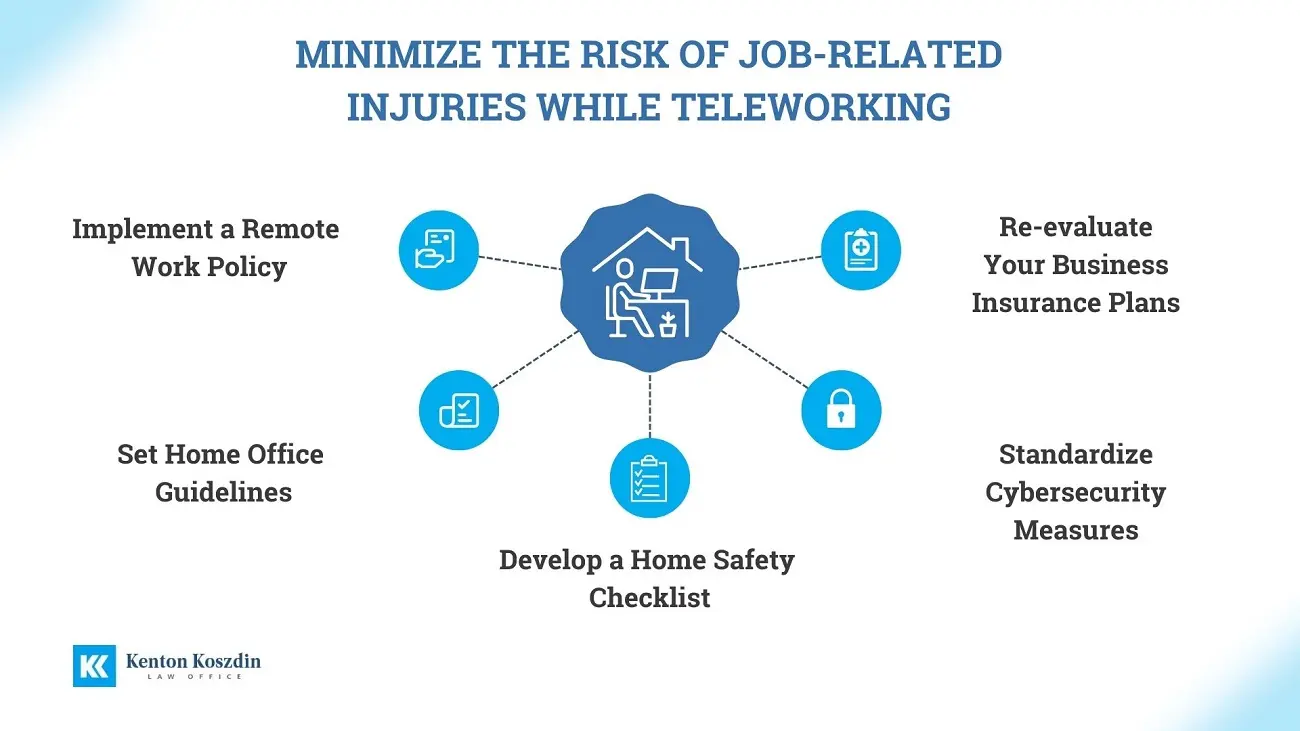Can Remote Employees Qualify for Workers Comp?
By Kenton Koszdin on September 17, 2023 | In Blogs
Most employers and employees are familiar with how workers’ compensation insurance functions in a traditional workplace. However, the rise of remote work has introduced new questions and challenges. Understanding how workers’ comp applies in a virtual workspace is crucial if you’re a remote worker or an employer managing a remote team.
At Kenton Koszdin Law Office, our workers’ comp legal team will shed light on this evolving landscape, providing essential insights into how remote workers can safeguard their health and access the benefits they are entitled to. Here, we unravel the complexities of workers’ comp for the remote work era.
Does Workers’ Comp Cover Remote Workers?
Most remote employees are eligible for workers’ compensation, but not every injury a remote worker suffers is covered under workers’ comp insurance policies. Eligibility hinges on several factors: the specifics of the injury, the jurisdiction in which the employer is based, and the terms outlined in the remote work policy.
What constitutes “work-related injuries” for those who are part of the remote workforce? Generally, any injury or illness suffered in the course of employment qualifies for compensation, no matter where the injury occurs. However, there are a few requirements:
- Timing: The injury must happen during work hours.
- Location: The injury must happen in a place the employee is reasonably expected to be during the course of employment.
- Actions: The employee must be fulfilling their duties or doing something related to their duties.
Workers’ compensation for remote workers typically adheres to the same guidelines as for those in more traditional work settings: Whether the injury happens suddenly (such as a minor burn) or develops over years (like carpal tunnel syndrome), the injury must arise in the course of the employee’s job to qualify for workers’ comp.
Is Workers’ Comp Required for Remote Employees?
Most states mandate that businesses with at least one employee carry workers’ comp insurance, and this requirement also extends to remote workers.
Workers’ comp insurance generally covers expenses related to an employee’s work-related injury or illness, including:
- Medical expenses
- A portion of wages lost during recovery
- Disability benefits
Some companies also purchase employer’s liability insurance. In the event that an employee decides to take legal action over their injury, the insurance company may cover:
- Legal fees
- Court-related expenditures
- Settlements or judgments
While most workers’ compensation cases are settled without going through the court system, employer’s liability insurance provides many business owners with peace of mind.
Common Work-From-Home Injuries
When people think of work-related injuries, they often imagine immediate incidents like falling off a ladder or getting burned. However, office workers are also at risk of injuries sustained during the course of their work.
Accumulative Harm Over Time
For many telecommuters, cumulative or accumulative harm is the common cause of injuries. These injuries develop over a longer period and are often linked to repetitive tasks or prolonged positions.
Examples include carpal tunnel syndrome, chronic back pain, or eye strain from staring at a screen for extended periods. These conditions can result from job duties requiring repetitive motion or poor ergonomics.
Filing a workers’ compensation claim for these kinds of injuries can be more challenging because the cause is not a single, easily identifiable incident. Yet, they are equally deserving of workers’ compensation benefits.
Every employee and employer should know how to prevent cumulative harm injuries at work. Consider the following quick ergonomics techniques:
- Input Devices: Position your keyboard and mouse so that your elbows align naturally under your shoulders and your wrists remain neutral.
- Monitor Elevation: Lift your monitor to eye level to reduce neck strain.
- Chair Setup: If your chair isn’t adjustable, use cushions or folded towels for seat height and back support.
- Posture: Aim to keep your hips and knees at roughly 90-degree angles and your feet flat on the floor (use a makeshift footrest if needed).
- Minimize Glare: Adjust window coverings to eliminate glare on your screen.
- Regular Breaks: Stand during calls and aim to move every 30 minutes to prevent stiffness.
- Use a Headset: Headsets free your hands and can help alleviate back and muscle fatigue.
Employers can provide tips like these in their remote work agreements.
Slips, Trips, and Falls While Working from Home
As a remote employee, you’re not immune to injuries due to slips, trips, and falls, even if your office is your living room. Whether you trip over a laptop cord, stumble downstairs while on a work call, or slip on a spilled drink while conducting work-related activities, such injuries can make you eligible for a workers’ compensation claim.
Follow these injury-prevention tips:
- Slips: Opt for grippy footwear over slippery socks, and swiftly clean up liquid spills and tracked-in debris.
- Trips: Declutter and illuminate your space; secure loose cords and focus on your path when on calls.
- Falls: Use handrails and avoid carrying heavy loads up or down stairs.
Working from home doesn’t negate the possibility of experiencing stumbles, tumbles, and mishaps — some of the most commonly reported workplace accidents. However, maintaining a safe work environment can reduce your risk.
5 Ways to Minimize the Risk of Job-Related Injuries While Working from Home
Taking proactive steps to minimize work-related injuries is essential in today’s growing landscape of remote work. If you’re an employer of remote workers, consider the following steps that promote a safer and more productive work-from-home environment.
1. Implement a Remote Work Policy
Drafting a well-defined remote work policy is the first step to minimizing the risk of work-related injuries. Such a policy should outline each employee’s roles, responsibilities, and expectations.
Clearly specifying what is considered “work time” and which activities qualify for workers’ comp for remote employees can clarify any ambiguity and protect both the employee and employer in the event of an injury.
2. Set Home Office Guidelines
Large or small business owners can establish a set of home office guidelines to help mitigate risks. These guidelines can dictate the proper ergonomic setup, including the height of tables, positioning of computer screens, and appropriate lighting.
By following such guidelines, remote employees are less likely to incur injuries that could result in workers’ compensation claims, medical bills, and a prolonged absence from work.
3. Develop a Home Safety Checklist
Creating a safety checklist for the home office can serve as a proactive measure to prevent job-related injuries. This checklist should include points like ensuring electrical cords are safely tucked away to prevent tripping, proper ventilation, and keeping work areas free of clutter.
Adherence to this checklist can go a long way in preventing injuries that would result in a workers’ compensation claim.
4. Help Employees Set Up Their Home Offices
Along with establishing safety standards and ergonomics guidelines, you can help protect your employees from injury by providing appropriate equipment.
Give employees a budget for setting up a proper home office, or supply high-quality equipment to allow them to complete their specific job duties. Be responsive to requests for accommodations, such as standing desks or frequent breaks, that will help employees work more comfortably.
5. Reevaluate Your Business Insurance Plans
Whether you’re a small business owner or manage a large team of remote workers, it’s vital to review your existing business insurance policies to ensure they offer adequate workers’ compensation coverage for remote employees.
Ensure your policy explicitly mentions and covers the risks remote workers may face. Doing so will help shield your business and employees from the financial hardships associated with work-related injuries, from medical bills to lost wages.
Filing a Workers’ Comp Claim by Remote Workers
If you suffer a work-related illness or injury at home, seek medical treatment and notify your employer about the injury as soon as possible. Document the incident, including how the injury occurred and any subsequent medical treatments, to help substantiate your claim.
Workers’ compensation policies have deadlines for applying for benefits, so acting promptly and following the correct procedures is important to ensure your claim is processed effectively.
Let Us Help You
Navigating the complexities of workers’ compensation as a business owner or remote employee involves taking proactive measures and thoroughly understanding policies and best practices. From ergonomic setups to safety checklists, a few preventive steps can minimize the risk of a remote worker’s injury.
However, if you find yourself dealing with a work-related injury, consider seeking guidance from a workers’ comp attorney at Kenton Koszdin Law Office. Don’t leave your health or financial well-being to chance; know your rights and act promptly to secure the benefits you deserve. Reach out for a consultation today.





